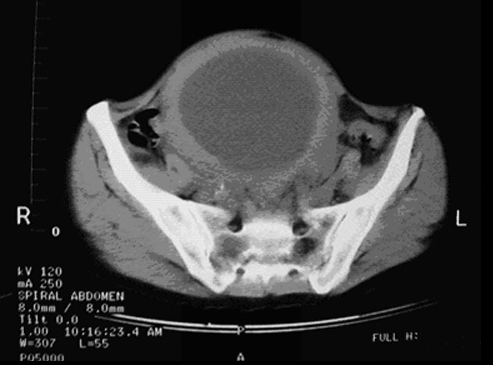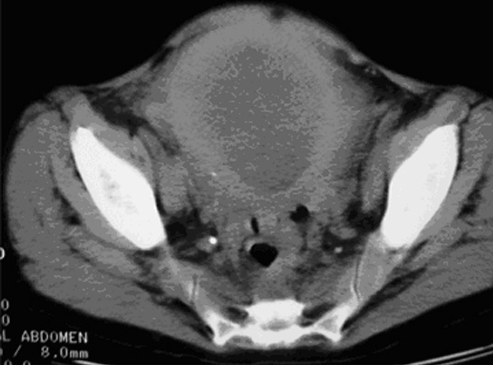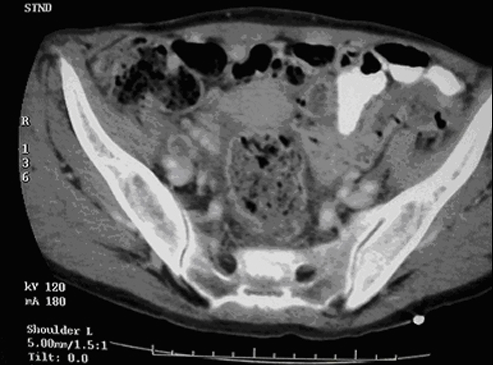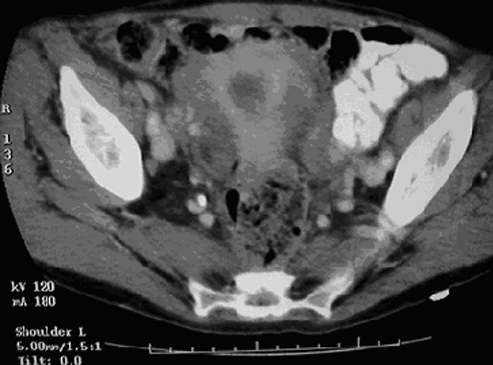Simoncini Cancer Therapy
Clinical case: Terminal carcinoma of uterine cervix
Clinical case: Terminal carcinoma of uterine cervix
Towards the middle of October 2002 I am called by the relatives of a 63-year-old patient. The patient is affected by carcinoma of the uterine cervix to which the doctors of the organization for terminal patients that have her in their care give a maximum life expectancy of about a month.
 Discharge document of October 21 2002 (PDF)
Discharge document of October 21 2002 (PDF)
I go to great lengths to explain to the relatives the therapeutic difficulties that exist when treating patients that are in such an advanced disease state. This is not because the sodium bicarbonate solutions are no longer effective, but because an endless number of uncontrollable events may intervene.
A first intervention, at any rate, can be performed only on the largest mass, while, for another mass which is in contact with the ileopsoas muscle and for other lesions that are in the liver, I warn them that it is necessary to wait for the evolution of the disease to decide if intervention is appropriate.
That notwithstanding, the relatives decide to proceed with my method of therapy.
The abdominal mass massively occupies the abdomen from the uterine cervix to the umbilicus, and it is in such an advanced stage that it infiltrates and compresses both rectum and urethras to the point that the implanting of two nephrostomachal apparatuses that allow the evacuation of urine is necessary.
Given the size of the mass, radiotherapists did not recommend even a palliative radiation therapy.



Report of the radiotherapists on October 9, 2002: PDF 1 PDF 2 PDF 3
Furthermore, a continuous fever is present, as well as a remarkable loss of weight and a persistent, painful symptomatology which is treated with analgesics.
After I visited the patient at home with the assistance of a radiologist colleague, it was decided immediately to position a catheter inside the mass for the purpose of draining the necrotic material as much as possible and subsequently to implement treatment with a sodium bicarbonate solution of five per cent in the attempt to destroy all the neoplastic colonies, and in the hope of producing cicatrisation of the neoplastic mass.
A treatment with sodium bicarbonate solution via vagina is also begun. After about two weeks, it is possible to inject only a few cubic centimetres of sodium bicarbonate. That indicates that a remarkable reduction of the mass has taken place and this assumption is supported by a descending transnephrostomical pyelography performed on November 15 2002 which reads a “regular flow of the calicopyelic cavities… the urethral constriction, at any rate, does not prevent the transit of the means of contrast which quickly reaches the bladder”.In other words, the patient begins to urinate in a natural way as well.
In the abdomen CAT performed on November 29 2002, the reduction of the mass is demonstrated.
Before our natural therapy (CAT of Sept. 13, 2002)


After our natural therapy (CAT of November 29, 2002)


After constantly improving the clinical conditions of the patient, it is decided that treatment with sodium bicarbonate solution at five per cent will be intensified, in the attempt to destroy the tumoral colonies as much as possible.
To this end, two catheters are positioned: one in the peritoneal cavity to inject the solutions into the floor of the small pelvis; the other directly into the hypo gastric artery which is afferent to the location of the uterine and rectal neoplastic mass.
Furthermore, nephrotomic apparatuses are eliminated and thus the external urine receptacles. That is achieved with the urethral positioning of two double J catheters.
Clinical situation in February 2003:
- The patient is living and in a condition of good health – to the point she can undertake independent train voyages hundreds of kilometres long in spite of the sinister prognosis predicting her death by November of 2002. The tumoral mass has been noticeably reduced.
- The painful symptoms have disappeared.
- The patient has started to gain weight again.
Declaration of the patient's family
“We the undersigned, L. Z., born in … on September …, and resident in …; and S. Z., born in … and resident in; and G.Oi, born in … on June and resident in …, respectively brothers and sister-in-law of G. Z., born in … on September… and resident in … and a patient of Dr. Tullio Simoncini, hereby testify on the development of the disease of the aforementioned patient, having followed in detail all its phases, starting from the first days of September 2002 up to the present.
Last September 12 G… was urgently hospitalised in the gynaecological division of the hospital of….
After the appropriate examination as well as a CAT scan of the abdomen, the presence of uterine neoplasia was ascertained. Because of its dimensions, the neoplasia was compressing both the urinary tracts and the intestine and simultaneously causing a renal and intestinal block.
The renal block was remedied with the application of bilateral nephrostomic apparatus and the intestinal block was remedied with occasional enemas.
The head physician of the department, on the basis of the CAT report, called the relatives of the patient and clearly and openly said that her condition was totally hopeless because she was carrying a uterine tumour that was so developed that it could not possibly be operated on. The only possibility left at that point was to attempt radiotherapy or chemotherapy to reduce the tumoral mass so that it could be operated on – but that was a possibility so remote as to be almost nil.
In the following days, the results of histological examinations and the opinions of the specialists as to the devastating effects that radiation therapy or chemotherapy inoculations would have had on the already fragile body of the woman, whose weight was only 32 kgs, induced the team of the department to abandon any attempt to save the patient.
Only the head doctor kept open the proposal of chemotherapy to stretch – perhaps by a few weeks but certainly not months – the life of the woman. The life expectancy from that time on (middle of September) was about two months: however, were chemotherapy to have had some effect, G… could have survived until Christmas.
At that point, the undersigned went to the Ccancer Unit of di Milano with all the clinical documentation available – and without the patient, because she could not be moved – to hear the opinion of a centre that was highly qualified in that field. The doctor who examined the scans expressed the conviction that that tumour was at least five years old and agreed with the statements issued by the doctors of the hospital of….
To make the departure of the lady as comfortable as possible (renal and intestinal blocks were foreseen as well as vomiting of feces and so on), the use of traditional therapies was not recommended and the only therapy proposed was that of pain control.
After the opinion of theCancer Unit, the head doctor of the … hospital, being confirmed in his conviction and in consideration of the uselessness of the hospitalisation, discharged the patient. However, a sudden worsening of G…’s condition forced a second hospitalisation and it seemed that the end was near.
While this second hospitalisation period was in progress, as we were not resigned to the destiny of the sister, the brothers kept on looking for an alternative that could yield some hope. It was at this point that, through the direct experience of some acquaintances, we heard about the therapy of Dr. Tullio Simoncini.
Immediate telephone contact was made with the doctor and G…’s clinical situation was explained. He offered the possibility of experimenting with his therapy. The decision to attempt this new road found immediate approval both from the patient (who on various occasions already expressed to both doctors and relatives her will not to undergo either surgical interventions or radio or chemotherapy treatments), and by the relatives.
In the meantime the hospital saw no reason to keep the patient any longer, notwithstanding that the tumoral mass grew enormously (the patient’s abdomen was as swollen as that of a pregnant woman). The patient was entrusted to the service of Palliative Care, which opted for home-based treatment since that was more adequate to the psychological inclinations of the patient.
On October 21, 2002, the lady was finally discharged by the … hospital. On the 25th day of the same month, Dr. Simoncini came to G…’s house. From the CAT scan documentation he understood immediately that the enormous tumoral mass was filled with liquid that had to be evacuated immediately. And so he did. From the abdomen almost one litre of purulent liquid came out.
What happened was that an abscess formed on top of the tumoural mass. The abscess was probably at the origin of the massive infection in progress, which was indicated by the high body temperature. After the intervention, the patient had a feeling of emptiness and faintness, but she gradually normalised.
The tumour was emptied of its purulent contents and instead of that content, through a permanent catheter, a certain quantity of sodium bicarbonate was injected. Dr. Simoncini took care to scrupulously show the relatives the therapeutic procedure to follow. On the effectiveness of the therapy, he said not to have any illusions: it was necessary to wait several days to see how the patient would respond. Many variables were playing against the patient, amongst them the advanced condition of the disease and irregular responsiveness.
The doctor stated that, according to his statistics, when the action of the bicarbonate is positive from the beginning, its effectiveness continues up to the end – that is, in case of positive response, within three to four months and sometimes even less, the problem could be solved. Conversely, if the bicarbonate were to be ineffective from the beginning, it would have been ineffective throughout. It was therefore alright to have hope without, however, having excessive expectations of recovery. At any rate, given G…’s condition, a condition that was equivalent to a death sentence, according to both the relatives and the patient herself, there was nothing to lose in attempting this new road.
After the intervention, since one abdominal catheter was added to the two nephrostomic apparatuses – thus increasing the danger of infection – Dr. Simoncini prescribed five vials of antibiotics to inject intramuscularly. The sodium bicarbonate was also prescribed as a vaginal douche so that the tumoral action was circumscribed as much as possible. The doctor, after making sure of having explained everything with the maximum possible clarity, and after confirming all his availability for further clarifications and intervention, returned to Rome.
The day after, the patient was already improving, and that was confirmed by the family doctor during his visit. As the days went by, the improvements became more and more evident, as the fever quickly diminished and eventually disappeared, while there was no longer need for antibiotics other than those prescribed by Doctor Simoncini. In the meantime, G… felt again the stimulus to urinate naturally while intestinal evacuation went back to normality and regularity.
These were clear signs that the pressure exercised by the tumoral mass on the urethras and intestine was decreasing. The confirmation came after a month, when a CAT scan was performed by the Busto Arsizio hospital. The scan showed that the tumoral mass was considerably reduced.
The hospital doctors proposed chemotherapy again at this point, but Gabriella clearly refused to undergo such treatment. Doctor Simoncini , comforted by the excellent results already obtained and respecting the will of the patient, set up to proceed towards a more targeted intervention to the end of denying the tumour any possibility of expansion. That endeavour had the full consensus of the patient and the family.
On December 14 2002, the patient visited Dr. Simoncini in Rome. Two catheters were applied – one arterial and one peritoneal – through which she continues her therapy to date. After the Christmas holidays, G… had the joy of removing the two nephrostomic apparatuses and started urinating exclusively urethrally, even though for the time being the ureters are sustained by double Js that have been positioned by Dr. Simoncini during the second visit to Rome.
After this last intervention, G…’s quality of life has noticeably improved: she moves on foot and in cars in a completely autonomous way, good spirits are back, and she actively supports and divulges Dr. Simoncini’s therapy to friends and acquaintances.
The news of the judicial investigation started against the doctor who has given back life and serenity back to G… has surprised us immensely. These undersigners were resigned and ready to face the death of our sister. But for this reason they would have stated that the hospital’s doctors were killers as they in good faith acted in her best interest with the therapeutical instruments that their school of medicine made available. Instead, the theory of Dr. Simoncini has produced a therapy capable of bringing G… Z… back from death to life, from desperation to hope and trust, from tears to smiles.
Can this be called fraud?
In spite of these results, which in themselves are exciting and deserving of the greatest gratitude, we know that cancer is a horrible and implacable enemy, and thus it eventually may prevail over our sister. If this is the case, can we call homicidal he who has been as much as he could, the saviour of the patient?
The undersigned declare themselves available to confirm, upon request, the contents of what is stated above in the appropriate forum and specify that we have preferred not to involve the patient directly in order not to cause further psychological stress at such a delicate moment.
Februrary 9, 2003
L..Z.
S. Z.
G. O.
[/learn_more]
* The improvements are therefore evident. A CAT scan of June, 2003, however, although highlighting the constant regression of the main tumoral mass, reveals that in the anatomical areas that were not previously treated – liver (totally substituted) and lesion of the ileopsoas muscle– the disease tends to progress quickly and brings the patient to her death at the end of the year.
Communication
Telephone: (+39) 3389997821
Telephone: (+39) 335294480
Email: t.simoncini@alice.it
Disclaimer
The information we provide is for educational purposes only and is not intended as medical advice. Users assume all responsibility for the application of the content on themselves. The information and/or products which on this website are reproduced are not meant to replace and/or to ignore the advice of a practicing physician.
